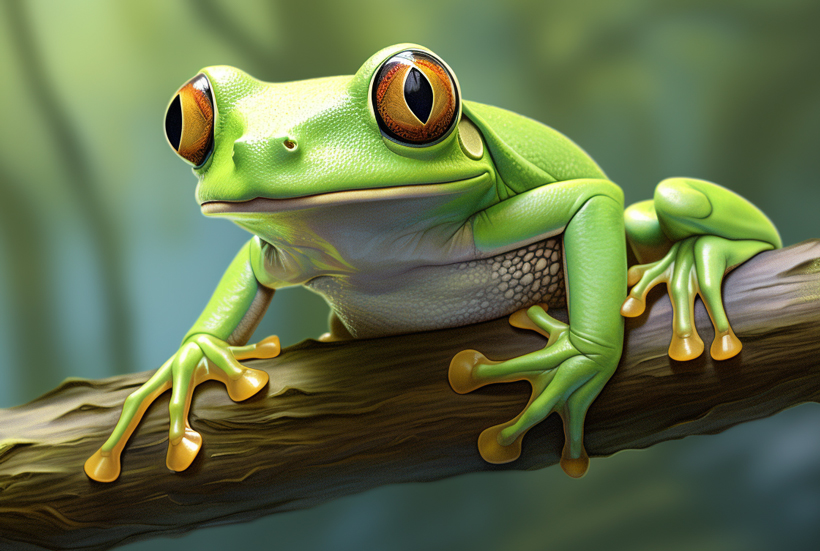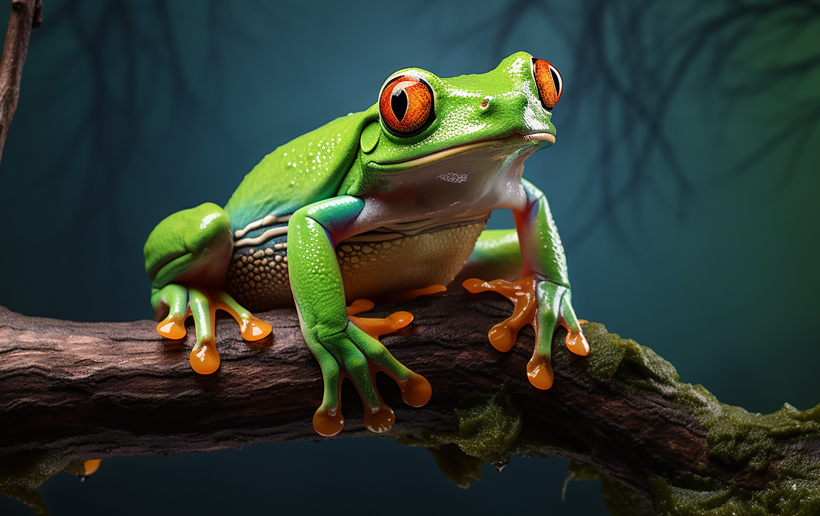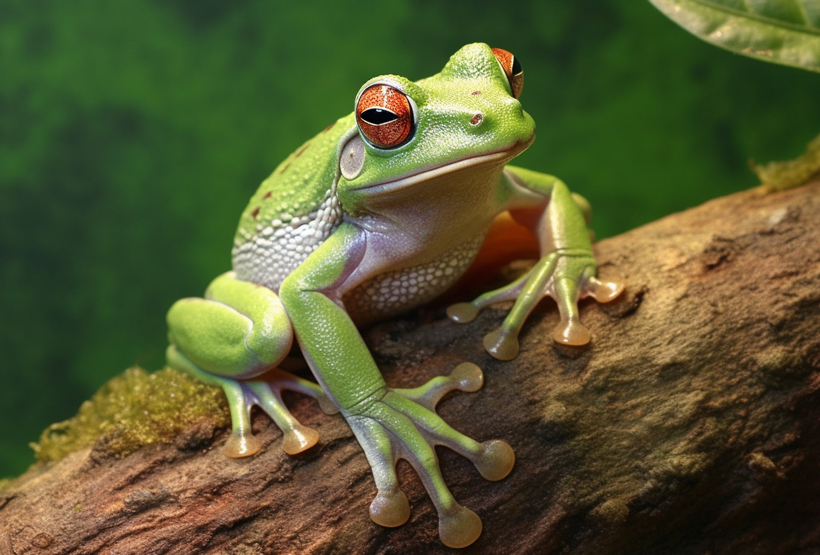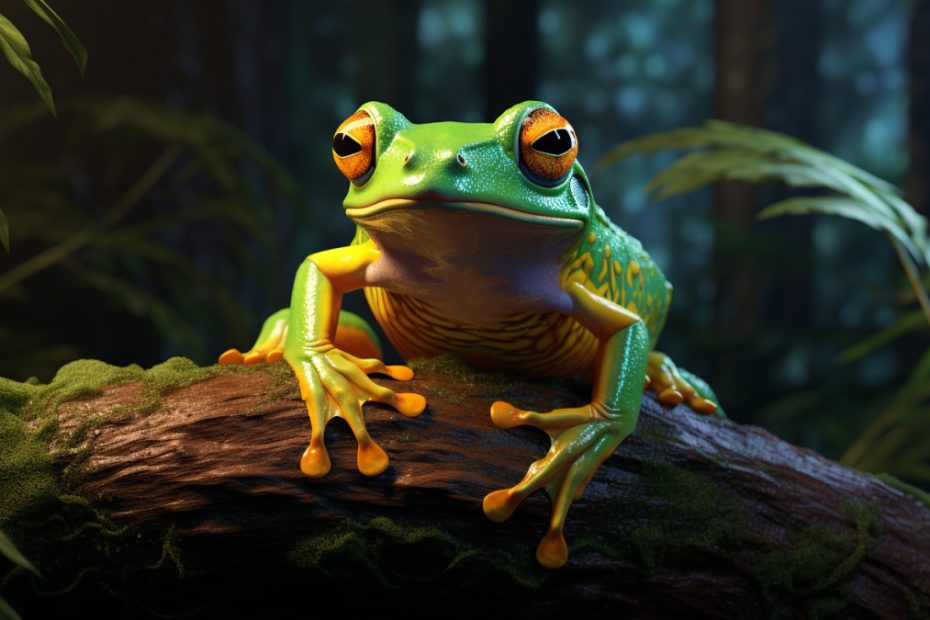Taking care of a tree frog can be a rewarding and educational experience. They are among the simpler frogs to take care of, even for someone who is new to it. It’s not too tough to maintain the ideal environment for these resilient amphibians.
So, how to take care of a tree frog? Provide him with a comfortable place to live. Ensure nutritious food and it is free from various diseases.
In this article, we’ll explore the essential aspects of tree frog care, from setting up their enclosure to maintaining their health and well-being.
How to Set Up the Perfect Terrarium for Your Tree Frog?

Preparing a home for your tree frog is essential to ensure its health and well-being. Tree frogs are delicate amphibians that require specific environmental conditions to thrive. Here’s a step-by-step guide on how to prepare a suitable habitat for your tree frog:
Step 1: Choose the Terrarium
Choose a terrarium that is at least 10 gallons and relatively tall. Tree frogs love to climb, so you need to give them plenty of space to do so. The terrarium should also have a screened lid to prevent your frog from escaping.

Step 2: Substrate
Line the bottom of the terrarium with a substrate that is moist and absorbent. Coconut fiber or bark bedding is a good option.
Add 2 to 3 inches of bedding made of bark or coconut fiber to the terrarium’s bottom. At least once per week, scoop the poop, and once per month, totally change the bedding.
Step 3: Add live plants
Fill the terrarium with live plants. This will provide your frog with places to hide and a sense of security. You can also include some artificial plants, but make sure they are safe for frogs to consume.
Step 4: Decoration
Add some branches or logs to the terrarium for your frog to climb on. You can also add some rocks or driftwood to create hiding places.
Step 5: Humidity
The humidity level should be between 50 and 60 percent during the day and 80 to 100 percent at night. Never, ever, let the humidity level drop below 50%. If necessary, install a fogging or misting system to keep the humidity constant.

Step 6: Water Source
Place a water dish in the terrarium. The water dish should be large enough for your frog to submerge itself completely. Change the water daily to keep it clean and fresh.
Step 7: Temperature and Lighting
Place the terrarium in a calm area away from the sunlight. As a nocturnal creature, it will probably sleep during the day.
There needs to be 10–12 hours of fluorescent lighting every day. If a ceramic heater is not being utilized, an incandescent day bulb can be used instead. Low-level UVB lighting is advised, but it should also be possible to hide from the light when necessary.
Feeding And Diet Of Your Tree Frog
The feeding and diet of your tree frog are crucial aspects of their care. Here are some general guidelines on feeding and diet for most tree frog species:

1. Live Insects:
Tree frogs are insectivores, which means they eat insects. They should never be fed vegetables, fruits, or human food of any kind. The specific insects that you feed your tree frog will depend on its species and size. However, some common insects that are fed to tree frogs include the following.
- Crickets
- Mealworms
- Waxworms
- Fruit flies
- Black soldier fly larvae
- Roaches
- Pinkie mice (for larger frogs)
2. Gut Loading:
It is important to gut-load the insects before feeding them to your tree frog. This means providing insects with high-quality food, such as fruits, vegetables, and leafy greens. This will ensure that your tree frog is getting the nutrients it needs.
3. Frequency:
The frequency of feeding will also depend on the species and size of your tree frog. In general, adult tree frogs should be fed every 2-3 days. Juvenile tree frogs should be fed every day or every other day. Offer as many insects as your frog will consume in a single feeding session.
4. Monitoring:
Keep an eye on the health of your tree frog. If your frog gains or loses weight, adjust its nutrition accordingly.
5. Water:
Ensure that your tree frog always has access to fresh, chlorinated water. Maintain the proper humidity levels in the enclosure because some tree frog species may also absorb water through their skin.

6. Supplements:
For optimum health, tree frogs require vitamin and mineral supplements. Add daily calcium powder with D3 and minerals supplements to food and multivitamin supplements once or twice a week.
7. Additional Tips for Feeding Your Tree Frogs
The following things will help you feed your tree frog:
- When feeding your tree frog, make sure to offer it insects that are no larger than the distance between its eyes. This will help to prevent your frog from choking.
- Remove any uneaten insects from the terrarium after a few hours.
- Feed your frog in a quiet place where it will not be disturbed.
- Do not feed your frog wild-caught insects. These insects may carry parasites or diseases that can harm your frog.
- Avoid feeding your frog processed foods, such as dog or cat food. These foods are not designed for frogs and can lack the nutrients they need.
- By following these tips, you can ensure that your tree frog is getting the proper nutrition it needs to stay healthy and happy.
Common Health Issues For Tree Frogs: Symptoms And Suggested Action

Here are some of the most common health issues in tree frogs and their symptoms, and suggested actions:
| Health Issue | Symptoms | Suggested Action |
| Metabolic bone disease (MBD) | Limping or difficulty moving | Provide your frog with a calcium and vitamin D supplement. |
| Soft or deformed bones | ||
| Red leg disease | Red, inflamed skin | The veterinarian will prescribe antibiotics to treat the infection. |
| Swollen legs | Keep your frog’s terrarium clean and free of moisture. | |
| Diarrhea | ||
| Skin Infections (Bacterial or Fungal) | Reddened or damaged skin | Maintain a clean enclosure with appropriate humidity levels |
| Blisters | Consult a veterinarian for diagnosis and treatment | |
| Abnormal shedding | ||
| Oodinium | White or gray spots on the skin | Apply a topical antifungal medication to the affected areas. |
| Itching | Keep your frog’s terrarium clean and free of moisture. | |
| Loss of appetite |
FAQ
This section answers some of the most common questions about how to take care of a tree frog:
It is generally not recommended to touch frogs or other amphibians with wet hands. Unless it is necessary for their care and you take proper precautions. Frogs have permeable skin, which means they can easily absorb chemicals, oils, and pollutants from your skin, including the oils and chemicals on your hands.
The number of tree frogs that can be kept together depends on the species of frog, their size, and their temperament. There are species of tree frogs that live solitary lives, such as the dart frog, the glass frog, and the moss frog. And should not be kept together, while others are more social and can be kept in groups.
Medium-sized species of tree frogs can be kept in pairs or small groups. It is generally recommended to keep 2-3 medium-sized tree frogs together in a terrarium.
Larger species of tree frogs can be kept in groups of up to 5 frogs. It is important to provide plenty of space for the frogs to move around.
Yes, some frogs can recognize their owners. This is especially true for frogs that are hand-raised and handled frequently. These frogs may come to associate their owners with food and positive experiences. They may even show signs of excitement when they see their owners approaching.
However, not all frogs are capable of recognizing their owners. Some frogs are more solitary and do not form strong bonds with humans. Additionally, some frogs may be stressed by being handled, and they may not associate their owners with anything positive.
Final Words
Caring for tree frogs can be a delightful experience when you provide them with the right environment, nutrition, and attention. Replicating their natural habitats and adhering to their specific needs. The health and happiness of your tree frog can be ensured.
Remember to stay informed and observe their behavior. Adapt your care routine to create a thriving and enjoyable environment for your amphibian friend.

Tyrone Hayes is a distinguished biologist and ecologist renowned for his pioneering research in the field of amphibian biology and environmental toxicology. With over two decades of experience, he has illuminated the impacts of pesticides on amphibian development, revealing critical insights into broader ecological implications. Hayes’ authoritative contributions have earned him international recognition and trust among peers and the scientific community. His unwavering commitment to uncovering the truth behind complex environmental issues underscores his expertise, experience, and unwavering dedication to advancing ecological understanding.
